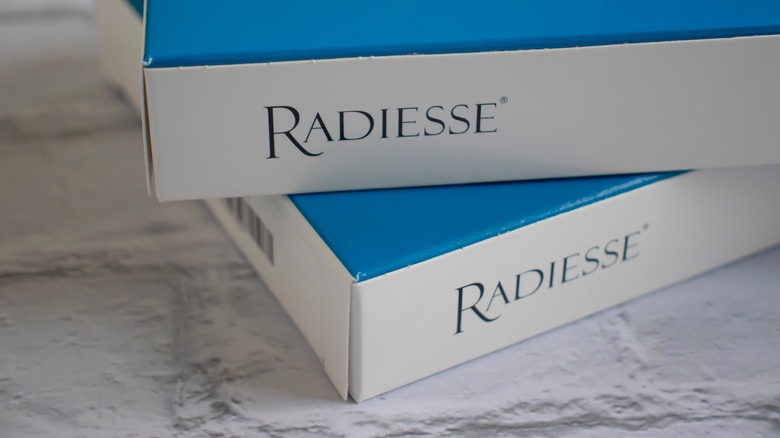Radiesse Vs. Juvederm: What's The Difference?
Cleveland Clinic reports that more than three million people in the United States get dermal fillers yearly. Several celebrities, including Khloe Kardashian and Courteney Cox, have opened up about getting this nonsurgical procedure, and chances are you or someone you know has dermal fillers. Dermal fillers can provide individuals with a plumper face or lips. In addition, they can reduce signs of aging by filling in wrinkles and fine lines. Although they can cost hundreds if not thousands of dollars, getting dermal fillers is relatively easy. The injections take minutes and have minimal recovery time.
There are several types of dermal fillers, but some of the most popular include Radiesse and Juvederm. They both provide similar results in reversing signs of aging by targeting fine lines and wrinkles around the cheeks, jawline, and mouth. Like all dermal fillers, Radiesse and Juvederm are temporary. So which one should you choose? Experts note that Radiesse and Juvederm are equally remarkable in providing a patient with a more youthful appearance. It all comes down to what your doctor recommends for your desired results. However, one thing to note is that Radiesse and Juvederm have different formulas.
Juvederm results don't last as long as Radiesse
The chemical composition of Juvederm and Radiesse make all the difference between the two. While Juvederm has a hyaluronic-acid-based formula, Radiesse features calcium microspheres. The latter stimulates the production of collagen and hyaluronic acid in the skin. This is especially important when creating a youthful appearance; collagen breaks down as we age, causing wrinkles and sagging. This also makes Radiesse more potent. On average, Juvederm results will last for a year. Radiesse, however, can last for 18-24 months. Dermatologist Macrene Alexiades, M.D. explained to Oprah Daily, "Hyaluronic acid injectables are excellent for filling and lifting the skin, but Radiesse is superior for bone recontouring."
She added, "Radiesse is closer to the chemical structure of human bone and yields an impactful, durable result." Ultimately, you can expect to pay more for Radiesse than Juvederm because of its long-lasting quality and ability to provide immediate results. As for Juvederm, it comes in different formula variations to address specific concerns. For example, Juvederm Voluma XC can enhance the cheeks, while Juvederm Vollure XC filler can decrease folds and wrinkles. Radiesse can do this and de-age your hands with fillers by increasing their volume to hide veins and bones. Unlike Juvederm, Radiesse cannot be used on the lips.
Radiesse can't be dissolved
One thing to know about getting hyaluronic acid-based fillers like Juvederm is that they can be dissolved if you are unhappy with your results. If you can't wait a year for them to dissolve naturally, you can go to your dermatologist so for a hyaluronidase injection. Dermatologist Daniel Belkin, MD, explained to AEDIT what this is. He said, "Hyaluronidase is an enzyme that occurs naturally in the body to break down hyaluronic acid, which is a naturally occurring molecule that helps give turgor and support to our skin and joints." Hyaluronidase can be injected anywhere where you received filler and Belkin told AEDIT that you'll see results in a day.
However, if you choose to get Radiesse, you're stuck with your results for 18-24 months. Dermatologist Dr. Blair Murphy-Rose told Byrdie, "The most important difference is that Radiesse cannot be dissolved or reversed the way that hyaluronic acid-based fillers can, so it has increased risks compared to hyaluronic acid fillers." Significant complications include cellulitis and necrosis. Nevertheless, Radiesse and Juvederm have similar minor temporary effects like bruising and swelling. Greater risks include allergic reactions and infections. Whether you choose Radiesse or Juvederm, talk to your dermatologist about any questions or concerns you might have about dermal fillers.


